Mountains and family/Mt. Eboshi
The view unraveled as I approached Mt. Minamisawa. Beyond the deep valley carved by the Kurobe River, the undulating peaks of Yakushi, Goshikigahara, and Tateyama languish in the distance, the upper parts concealed by clouds and ample snow valleys cloaking the broad valleys in whiteness. I descend the white gravel slope viewing the pointed peak of Mt. Suisho pierce the clouds and cross a marshy area blooming with Geum pentapetalum flowers. The gas disperses to reveal a rounded granite massif.
In February 1907, Hiroshi Yoshida returned from a three-year overseas jaunt with his sister-in-law, Fujio Yoshida. They tied the knot in April of that year, and their first daughter Chisato was born the following year. By this time, Hiroshi had chalked up numerous awards at various exhibitions and was established as a talented young artist in the world of Western-style painting, both in his own mind and by others.In 1911, Hiroshi’s first son, Tōshi, was born, and while his public and private life seemed to be going swimmingly, a dark shadow was looming large over his private life.
On a harvest moon in mid-autumn, just two months after Tōshi was born, his beloved daughter Chisato contracted epidemic dysentery and died at the mere age of three years and two months. Further still, the previously healthy Tōshi was suddenly stricken with a high fever, the upshot of which was that his legs became paralyzed and was unable to walk. They tried every treatment going, with Hiroshi by his side during rehabilitation. This intensive treatment perhaps paid off, as Tōshi was able to walk again by the time he entered elementary school. While the end of the Meiji period was a time of great torment for Hiroshi, the start of the Taisho period marked a most energetic foray into the Japanese Alps. Every summer, he spent one to two months there, producing mountain landscape masterpieces that would come to represent his work.
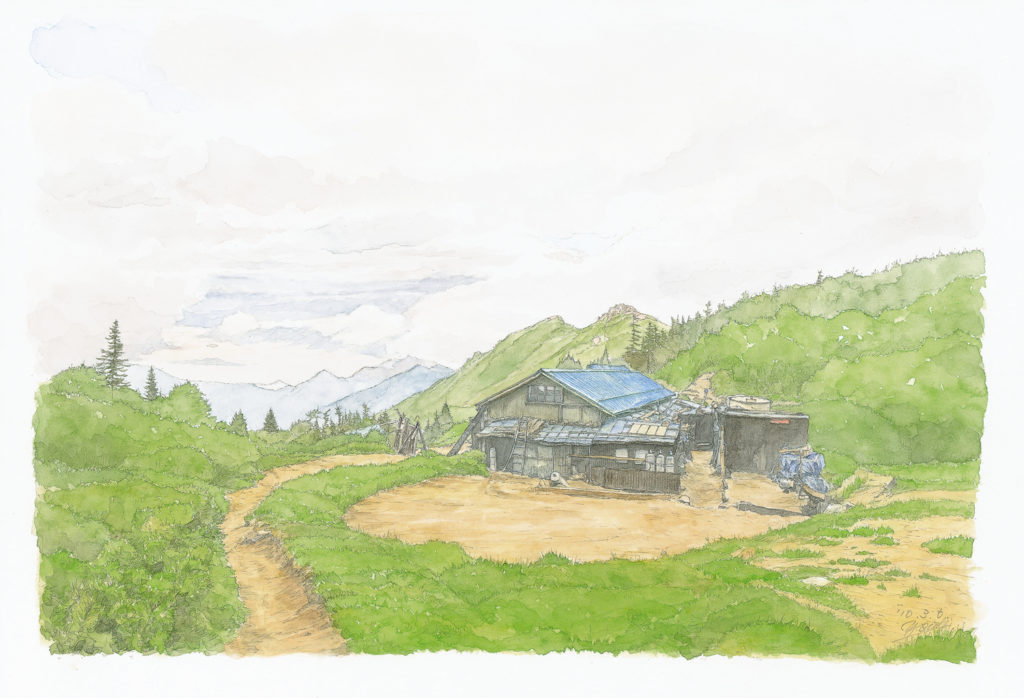
illustration | Yohei Naruse
Traipsing up a gentle path that winds through dwarf stone pine trees, we come to the base of the mass of rock. After tackling an undulating rocky slope, we traverse a rocky ledge before scrambling up to a yet higher rock – the summit of Mt. Eboshi. The west face of the massif is completely sheer, with a slab-like smooth rock surface protruding into the valley. Sensing the piercing light, I look back to see Mt. Noguchi-Goro basking stoutly under the faint blue sky.
Their second son was born in 1926, 15 years after Tōshi’s birth. So enamored with the mountains was Hiroshi at this point that he proudly named his second son “Hotaka” after his favorite mountain. Fujio describes that time of their life in her book “Scarlet Leaf Diary”.
Our second son Hotaka was born in 1926, at a time when we were climbing a lot of mountains like Mt. Hotaka and so named him after it. Honestly speaking we would have wanted to name our eldest son after a mountain but couldn’t agree on a decent name. We thought about “Hakusan” half-jokingly, but it sounded like a quack doctor or something, so I insisted that we call him something else, which ended up being Tōshi. The two sons were born 15 years apart, during which time a lot of mountains were climbed, so the name “Hotaka” from the Northern Alps seemed very apt.
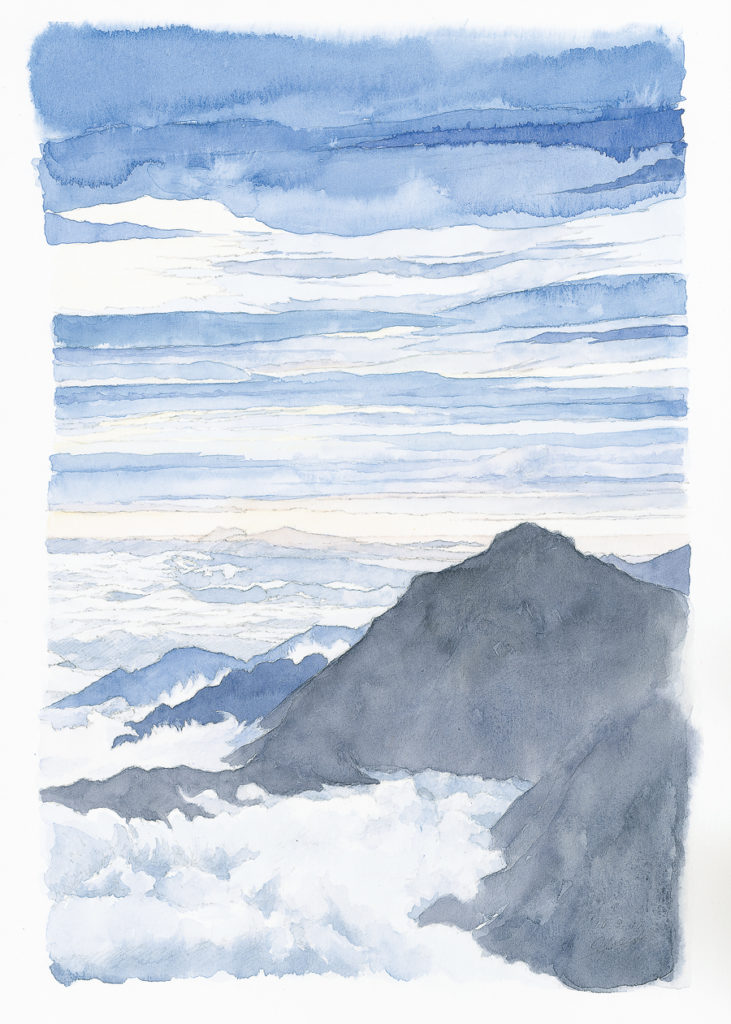
illustration | Yohei Naruse
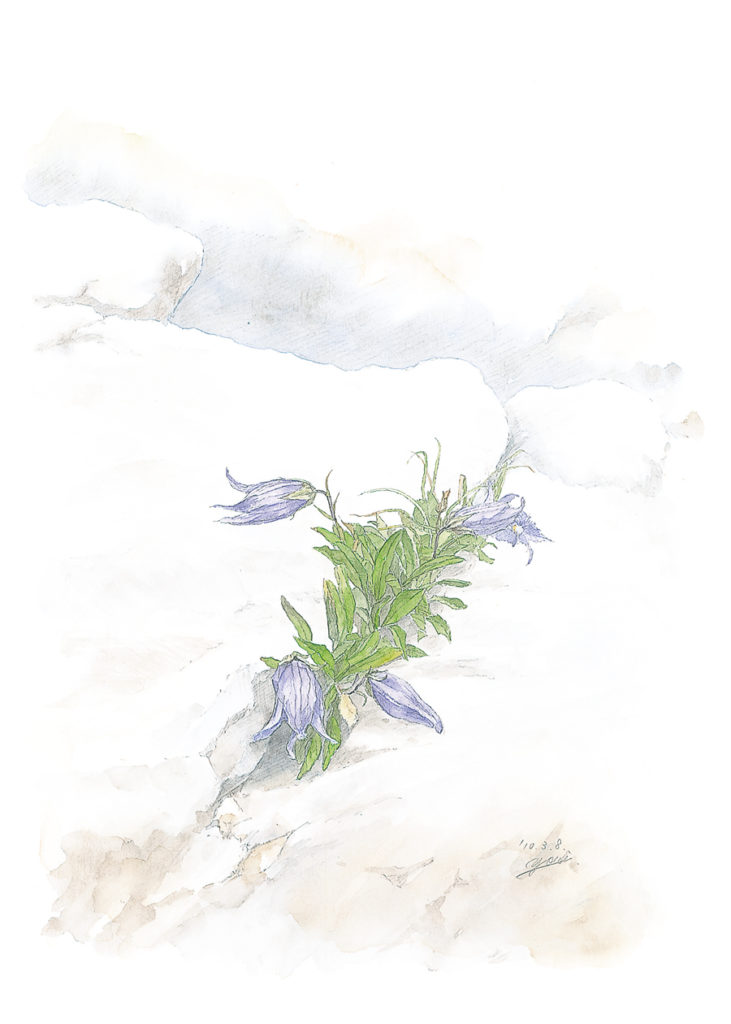
illustration | Yohei Naruse
Hotaka Yoshida also left an interesting memoir about his own birth:
When I was born, my head was unusually elongated, so when my father saw it, he immediately said, “Let’s call him Eboshi!” After my mother’s vehement objection, he settled on ‘Hotaka.’ Considering that my father never backed down once he had made a suggestion, I think I should thank my mother for not allowing me to be called Yoshida Eboshi.
The year of Hotaka’s birth, 1926, was also the year Hiroshi published “Twelve Views of the Japan Alps,” including “Sun Rising Over Eboshi Dake,” and in March, Mitsukoshi Department Store in Nihonbashi held the “Hiroshi Yoshida Mountain Landscape Painting Exhibition”. This episode regarding the naming of his second son gives us a glimpse of just how deeply attached Hiroshi was to mountains at that time.
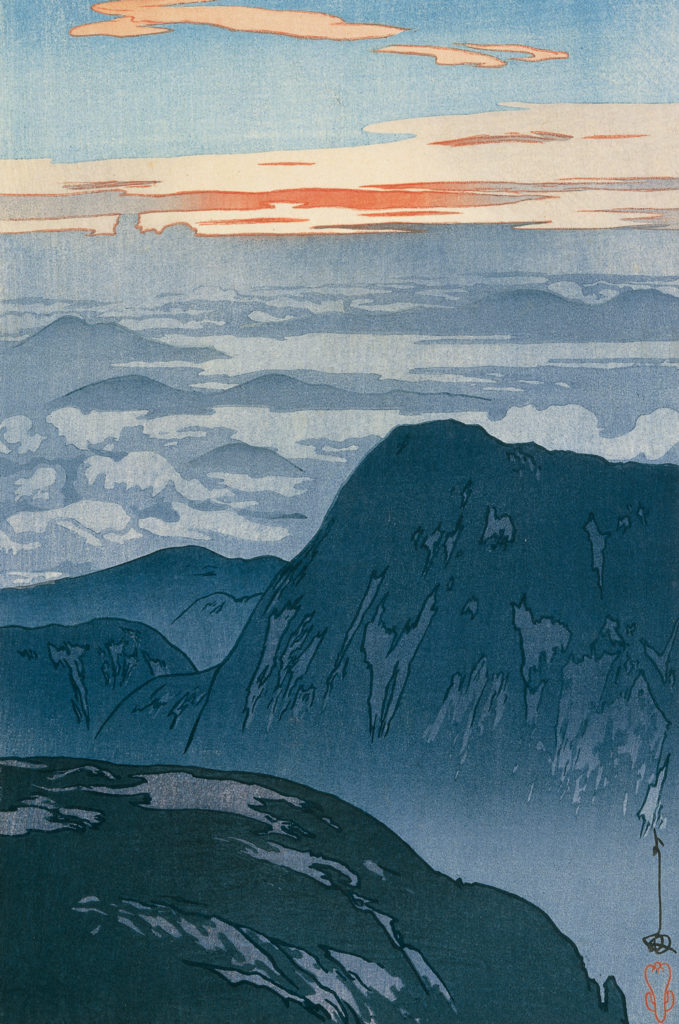
I rise before dawn, have a quick breakfast, and crawl out of the tent. The midnight rain has stopped, and the stars shine faintly through the thin gas. To see the sunrise, I head for Mt. Mae-Eboshi, the peak before Mt. Eboshi. The orange-tinted eastern sky forms a band of light above the blue sea of clouds that straddles the night and the morning. Mt. Karasawa is visible in a deep blue haze. It was just then that I noticed that the landscape before me bears an uncanny resemblance to “Sun Rising Over Eboshi Dake”.
The sky tinged with the morning sun depicted in “Sun Rising” is a view of the eastern sky. I thought the large peak depicted in the woodblock print was Mt. Eboshi, but the north side of Mt. Eboshi is a ridgeline that carries on to Mt. Minamisawa, and there is no valley such as that in the print. I also can’t find a place that gives a view of this kind of angle from the west. A large rock wall called Maku-iwa rises in the middle of Mt. Karasawa, and a rock face is also depicted in the print. The mountain depicted in the print almost must be Mt. Karasawa. It transpires that ” Rising Sun on Eboshi dake” does not depict Mount Eboshi itself, but rather the sunrise seen from it. “I love mountains that have a village on one side, a great view, and lots of changes to the weather”. These are the words of Hiroshi Yoshida, whose other works included a print depicting a sea of clouds stretching across the basin. Around 1920, Hiroshi painted an oil painting of the same name with the exact same composition, which we know is the basis for this print. This apparently featureless landscape was probably one of his favorite mountain landscapes.
The wind from the west has grown stronger. Huddled in the shadow of the layered stones, I stare out at the sea of clouds, which is gradually regaining its whiteness while turning a pale purple. The lights of the Takase Dam gleam low in the deep valley floor. Just when the sun seems to be momentarily tinting the mountains, it is suddenly obscured by a band of clouds Beneath the gray clouds hanging from the sky, the mountains silently greet the morning, untainted by dawning red rays.
<PAPERSKY no.32(2010)>
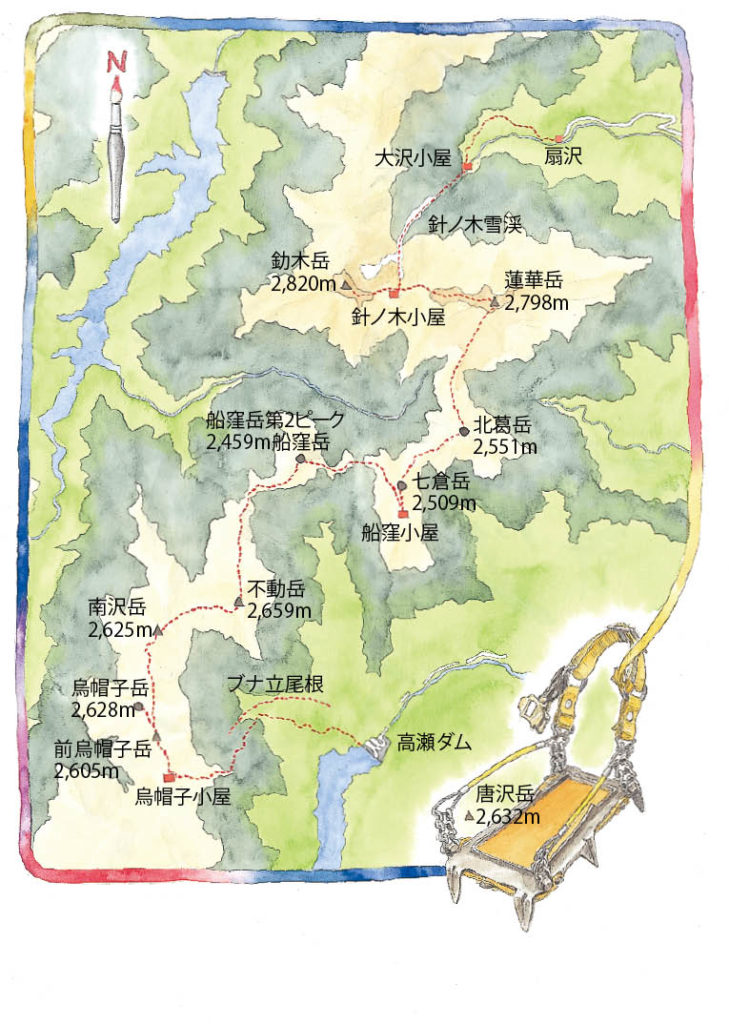
route information
The rock mass of Mt. Eboshi looks elongated and dome-shaped when viewed from the east and jagged when viewed from the south, making it a distinctive peak bearing a striking resemblance to an Eboshi (traditional “Raven’s Cap”). A popular route is from Takase Dam to Buna-tate Ridge, known as one of the three most punishing ascents in the North Alps. The traverse between Mt. Renge and Mt.Eboshi is not for the faint of heart, due to the many collapsed areas and unrelenting ups and downs. If you traverse south from Mt. Eboshi and cross Mt. Noguchigoro, the famous peaks of the Northern Alps such as Washiba and Suisho come into view. To the west is Kumonodaira, and to the south the ridge line continues toward Mt. Sugoroku and Mt.Yarigatake. The ridgeline from Eboshi to Yarigatake is well-trodden route called the “Ura-Ginza” traverse. Hiroshi mentions this route as a place where he could have a snooze in a grassy meadow, ogle the mountains, and paint. To reach Takase Dam, take a cab from Shinano-Omachi Station.
Yohei Naruse
Born in Gifu Prefecture in 1982. Graduated Tsuru University, Graduate School. Following a stint in advertising, he currently works as a freelance writer and illustrator.











